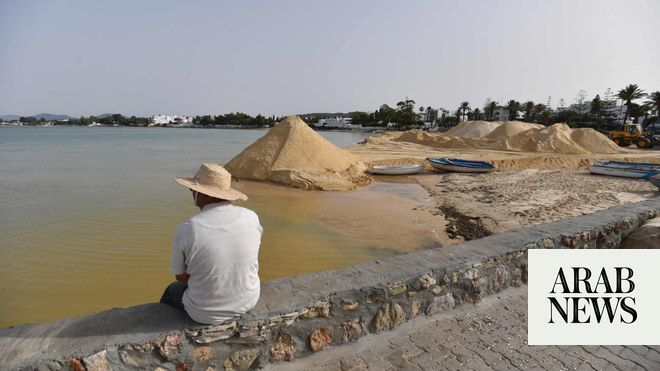HAMMAMET, Tunisia: In the coastal town of Hammamet, Tunisia, bulldozers diligently shovel sand from a nearby desert onto a popular beach in an effort to prevent it from disappearing due to erosion.
“This beach is the postcard image of Hammamet,” said environmentalist Chiheb Ben Fredj as he gazed nostalgically at the city’s iconic Yasmine Beach.
“It has been etched in our minds since childhood,” he added, as workers labored to restore Tunisia’s central coastline to its former sandy splendor.
As in many other coastal areas of North Africa, severe erosion in recent years has caused the disappearance of many of Hammamet's sandy beaches, putting a strain on this popular tourist destination located about 65 kilometers (40 miles) east of the capital Tunis.
Coastlines around the world are subject to constant natural flow, with the seas transporting and depositing sediment.
But human activity, including coastal real estate development and offshore sand mining, is significantly accelerating beach erosion.
Among other effects, construction and coastal defenses in a given area can prevent sediment from moving along the coast, depriving existing beaches of new material.
Studies have also shown that the effects of climate change, including rising temperatures and sea levels, are exacerbating the phenomenon.
In the Mediterranean, where the UK's National Oceanography Centre says sea levels have risen faster in the past 20 years than in the entire 20th century, coastlines are changing rapidly.
According to the United Nations, the sea is also warming at a rate 20 percent faster than the rest of the world.
The Tunisian coast has been an important asset for this struggling Mediterranean country, which this year aims to host about 10 million tourists.
Tourism accounts for up to 14 percent of the country’s GDP, creating tens of thousands of jobs in a country where unemployment exceeds 16 percent and among young people 40 percent.
According to official data from last year, Tunisia has already lost more than 90 kilometers of beaches due to erosion.
According to Tunisia, of the country’s 570 kilometers of sandy beaches suitable for swimming, 190 are at imminent risk of disappearing.
Most of the beaches most affected by erosion are located near cities.
Tunisian environmental groups, as well as the government's Coastal Protection and Development Agency (APAL), attribute the rapid erosion mainly to human activity and construction on the coast, which they say is further exacerbated by climate change.
“The construction projects were not designed to respect coastal dynamics,” an APAL official told AFP.
To save Hammamet beach, one of Tunisia’s worst-hit according to the World Bank, authorities last month began transporting about 750 truckloads of sand from the inland desert province of Kairouan, about 110 kilometers (68 miles) away.
APAL, which operates under the auspices of the Ministry of Environment, was racing against time to refill the beach before the peak of the tourist season.
But while rebuilding beaches, known as beach nourishment, may be a quick fix, “it’s not a sustainable solution,” Ben Fredj said.
“This sand may not last long,” added the secretary general of the Association for Environmental Education.
“In the event of a storm, it could be swallowed up in a matter of days,” he said, as happened in the summer of 2023.
The process can also be expensive.
Coastal authorities have estimated that the cost of restoring the sand on three beaches in Hammamet, Monastir and Sfax amounts to 3.9 million Tunisian dinars ($1.25 million).
But for locals, redeveloping their priceless waterfront is worth the expense.
Yasmine beach “is a showcase for Hammamet,” said Narjess Bouasker, who runs the town's Menara hotel and chairs the regional hotel federation.
“We need to take back our beach that the sea has swallowed up,” he said, calling for a balance between protecting the landscape, beloved by locals and foreign visitors alike, and combating coastal erosion.
“For us the priority is not to touch the beauty of the city,” he said.
Bouasker said he has noticed growing awareness among officials, but re-filling beaches with sand is still a gamble.
“We don't know how the sea will react,” he added.
